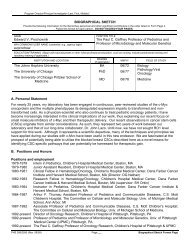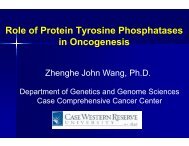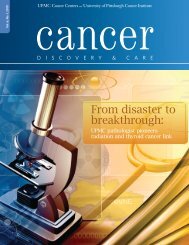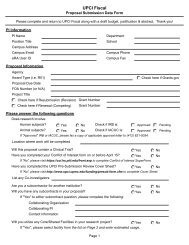Rodent Bedding technical info and Beddinig biblio[3] - University of ...
Rodent Bedding technical info and Beddinig biblio[3] - University of ...
Rodent Bedding technical info and Beddinig biblio[3] - University of ...
You also want an ePaper? Increase the reach of your titles
YUMPU automatically turns print PDFs into web optimized ePapers that Google loves.
Techinical <strong>info</strong> on PJ Murphy Sani chips 7090 Sani-Chips7090A Aspen Sani Chips"Unparalleled Quality Control"P.J. Murphy starts with only the most select hardwoods, which are debarked (nature's guard againstbacteria <strong>and</strong> disease) before the logs are sawn. Large pieces are removed before loading materials ontoP. J. Murphy's own trailers, via air conveying systems. Trailers are used solely for hauling hardwoodbedding to guarantee no contamination <strong>of</strong> tars <strong>and</strong> resins. Pine bedding is refused because at allhardwood facilities, only hardwoods are processed, avoiding any contamination which is inherent in alls<strong>of</strong>twoods. Once the material is shipped from the sawmill, it goes directly into an enclosed hopper. Thewood is removed from the hopper via a metered, precision ground auger into initial screeners, whicheliminate all coarse particles. From this point, the production system is completely closed. After theinitial screening, all desired particles are dropped through a rotary air lock into a 3 phase, 75 foot pass,where they are rotary drum dried, with a maximum temperature <strong>of</strong> 1200°F, for 20 minutes. This reducesthe moisture content to 8%, with a ± 2% variance <strong>and</strong> kills most harmful bacteria. Material is thenconveyed, by air, from the dryer to another set <strong>of</strong> sifters, screening to the final particle size. To furtherrefine the product, P. J. Murphy has added additional, innovative, <strong>and</strong> unique equipment, enabling themto further increase their screening <strong>and</strong> aspirating efficiencies. Sani-Chip is a cube-cut type bedding, free<strong>of</strong> splinters, shavings, slivers, excessive dust, <strong>and</strong> all foreign matter. It is aspirated a final time <strong>and</strong>augered into a 2.2 cubic foot, 3-ply Kraft paper bag, which is autoclavable.ExperienceSani-Chips have been used by the National Institutes <strong>of</strong> Health in Bethesda, Maryl<strong>and</strong>, National Centerfor Toxicological Research in Jefferson, Arkansas, National Toxicology Programs throughout theUnited States, many state <strong>and</strong> private universities, major pharmaceuticals, <strong>and</strong> many <strong>of</strong> the nation'sfinest breeders <strong>of</strong> laboratory animals.Also available in Irradiated formats:7990.BG Irradiated Teklad Sani Chips, Large Cap Sack7990.CS Irradiated Teklad Sani Chips, 4 x 3 lb. vacuum packs
<strong>Rodent</strong> <strong>Bedding</strong> <strong>biblio</strong> review Domer, DA, Erickson, RL etal. 2011. The Impact <strong>of</strong> <strong>Bedding</strong> Type on Cage Change out Frequency. -‐The frequency <strong>of</strong> cage changes varies among institutions as a result <strong>of</strong> several considerations: animal stress, allergen exposure to personnel, experimental interference, <strong>and</strong> costs associated with bedding <strong>and</strong> sterilization procedures. The goal <strong>of</strong> this study was to evaluate the effectiveness <strong>of</strong> a new sanitized corncob bedding material as compared with st<strong>and</strong>ard corncob in a ventilated mouse rack system. Intracage ammonia levels, bacterial growth <strong>and</strong> absorptive capacity <strong>of</strong> bedding were measured for cages <strong>of</strong> female C57BL/6 mice under st<strong>and</strong>ard <strong>and</strong> autoclaved conditions on static <strong>and</strong> ventilated racks in a barrier facility. Intracage ammonia concentration was measured daily, <strong>and</strong> cages were removed when measurements were equal to or greater than 25 ppm. Quantity <strong>of</strong> bacterial growth <strong>and</strong> bacterial species in bedding were determined at the time <strong>of</strong> cage removal. <strong>Bedding</strong> absorptive capacity <strong>and</strong> bacterial load were also evaluated in all conditions without the addition <strong>of</strong> mice. Cages with nonautoclaved sanitized corncob bedding took significantly longer to reach ammonia concentrations <strong>of</strong> 25 ppm than st<strong>and</strong>ard corncob. Autoclaved sanitized corncob bedding did not differ significantly from nonautoclaved st<strong>and</strong>ard corncob in length <strong>of</strong> time required to measure 25 ppm ammonia. All nonautoclaved sanitized corncob cages remained in the study a minimum <strong>of</strong> 3 wk. No significant differences were noted on bacterial load at the conclusion <strong>of</strong> mouse housing. St<strong>and</strong>ard corncob was significantly more absorbent than sanitized corncob bedding, <strong>and</strong> autoclaved sanitized corncob bedding was significantly more absorbent than autoclaved corncob. This study demonstrated that mouse cages with nonautoclaved sanitized corncob bedding on ventilated racks may be used with a cage change interval <strong>of</strong> 3 wk. Horn MJ, Williams SV, et al. 2010. The Impacts <strong>of</strong> Cage Density, Sanitation Frequency, <strong>and</strong> <strong>Bedding</strong> Type on Selected Measures <strong>of</strong> Animal Wellbeing, Health, <strong>and</strong> Cage Environment. AALAS Scientific Session. -‐The objective <strong>of</strong> this study was to evaluate the effects <strong>of</strong> cage density, sanitation frequency, <strong>and</strong> bedding type on animal growth, cage conditions, <strong>and</strong> animal welfare. Sprague–Dawley rats <strong>and</strong> C57BL/6 mice <strong>of</strong> both sexes at 3 wk <strong>of</strong> age were r<strong>and</strong>omly selected from production colonies <strong>and</strong> allotted into one <strong>of</strong> 12 treatments. Animals were allotted based on gender, bedding type, <strong>and</strong> cage density <strong>and</strong> sanitation frequency for an 8-‐wk period. <strong>Bedding</strong> material optimization trials involved comparison <strong>of</strong> shredded aspen, cellulose, or a 50:50 mixture <strong>of</strong> shredded aspen to cellulose, with internal cage density st<strong>and</strong>ards <strong>and</strong> sanitation procedures measured against those recommended by the Guide. Body weight, feed disappearance, cage ammonia <strong>and</strong> ATP concentrations, behavior, <strong>and</strong> morbidity <strong>and</strong> mortality were assessed weekly while fecal corticosterone <strong>and</strong> nasopharyngeal <strong>and</strong> cecal microbiology as well as lung histopathology (rats only) were monitored at the culmination <strong>of</strong> the trial. In Sprague–Dawley rats, none <strong>of</strong> these parameters were significantly affected by cage density, sanitation frequency, or bedding type. Spurious effects on feed disappearance, cage ammonia, <strong>and</strong> cage ATP were reported that did not appear to represent an important data trend. In C57BL/6 mice, parameters indicative <strong>of</strong> animal health <strong>and</strong> welfare were, in general, not significantly affected by cage density, sanitation frequency, or bedding type. However, periodic spikes <strong>of</strong> cage ammonia concentrations <strong>and</strong> ATP levels were recorded in cages housed according to internal cage density <strong>and</strong> sanitation frequency st<strong>and</strong>ards compared with Guide st<strong>and</strong>ards, <strong>and</strong> in cages bedded with aspen compared with cellulose or aspen-‐cellulose mixed bedding. Ongoing studies <strong>and</strong> historical data support the finding that slight deviance from the cage density <strong>and</strong> sanitation frequency st<strong>and</strong>ards set forth in the Guide does not negatively affect animal health, welfare, or
production parameters at our institution. These parameters appear to be credible measures <strong>of</strong> animal health <strong>and</strong> wellbeing <strong>and</strong> may be useful for evaluating performance st<strong>and</strong>ards for animal husb<strong>and</strong>ry. Krohn, TC, <strong>and</strong> Hansen, AK. 2008. Evaluation <strong>of</strong> corncob as <strong>Bedding</strong> for <strong>Rodent</strong>s. Sc<strong>and</strong>. J. Lab. Animal Sci. 35:231-‐236. -‐Previous studies have shown that the ammonia level in cages using corncob bedding is reduced compared to cages with aspen bedding. The reduced level <strong>of</strong> ammonia prolongs the interval between cage changing, <strong>and</strong> it may therefore be beneficial for the facility to use corncob. When analyzing the bedding’ ability to absorb water, corncob showed lower water absorption compared to aspen bedding; the more corncob in the mixture, the less water is absorbed. Both mice <strong>and</strong> rats rejected cages with pure corncob during the day, <strong>and</strong> none <strong>of</strong> the animals preferred corncob mixed with aspen, only equally accepted it. In conclusion, neither rats nor mice prefer corncob, even not is mixtures with aspen bedding <strong>and</strong> enrichment. In the light <strong>of</strong> the common st<strong>and</strong>ard for bedding being wood chips, <strong>and</strong> the lack <strong>of</strong> preference for corncob mixture corncob seems to be a poor alternative to wood based bedding. Leya, L, Mikusa, S etal. 2011 Effect <strong>of</strong> Corncob bedding with Aspen Chip <strong>Bedding</strong> on Rat EEG <strong>and</strong> Pain Models. AALAS Poster. -‐Nonexperimental variables can impact animal studies. We switched from aspen chip to corncob for its absorbency. Subsequently, rats in EEG studies were sleeping less during light cycle recordings. Sleep reduction can negatively impact the validity <strong>of</strong> EEG drug studies. We conducted a study to determine whether the corncob bedding was the cause <strong>of</strong> reduced sleep. Male SD rats were implanted with electrodes over the frontal <strong>and</strong> parietal cortices with a reference electrode implanted over the cerebellum. The rats were maintained on a normal 12:12-‐h light:dark cycle (lights on at 0600). Quantitative analysis <strong>of</strong> the EEG was performed using fast Fourier transform (FFT). Prior to the study, rats (n = 15) were on corncob bedding in both home cages <strong>and</strong> recording chambers for 5 wk, thus, were habituated to the bedding. Only the EEG chamber bedding was changed during the study. All rats were recorded on both bedding types on different days over the course <strong>of</strong> the experiment. Results showed that corncob bedding resulted in a significant decrease in the amount <strong>of</strong> time spent in slow-‐wave sleep during hours 0900 <strong>and</strong> 1000 as compared with aspen chip (P < 0.001 <strong>and</strong> P < 0.01, respectively; Bonferroni post hoc test). A 2-‐way ANOVA showed no effect <strong>of</strong> time (P = 0.2173), with a significant effect <strong>of</strong> treatment (P < 0.0001) <strong>and</strong> interaction (P = 0.0275). In addition, altered mechanical sensitivities were seen in rat models <strong>of</strong> inflammatory <strong>and</strong> neuropathic pain when rats were housed on corncob bedding compared with aspen chip. Additional overt pain behaviors were observed in corncob housed rats including protection (lifting) <strong>of</strong> the injured paw, pushing the bedding aside <strong>and</strong> a preference for areas free <strong>of</strong> bedding. These findings support other published literature suggesting that rats prefer wood chip to corncob bedding. The IACUC requested that all corncob bedding be removed from rodent cages based on this data. Locklear, J, Thigpen, J. etal. 2010. Corncob <strong>Bedding</strong> Spiked with Zearalenone Significantly Advances the Timing <strong>of</strong> Vaginal Opening in Immature CD-‐1 Haired <strong>and</strong> SKH-‐1 Hairless Mice. AALAS Poster
-‐We previously reported that the estrogenic mycotoxin, Zearalenone (ZEA), naturally found in commercially available corncob bedding significantly advances time <strong>of</strong> vaginal opening (VO) in CD-‐1 mice. ZEA is ubiquitous in corncob beddings <strong>and</strong> may impact estrogenic studies involving weak estrogenic endocrine disruptor compounds (EDCs). We conclude that the hairless mouse is more sensitive to ZEA than the CD-‐1 mouse <strong>and</strong> the primary route <strong>of</strong> exposure is via the skin, since mice were not observed ingesting the bedding. This study confirms our earlier report showing the ZEA in corncob bedding may significantly impact the results <strong>of</strong> studies evaluating the estrogenic activity <strong>of</strong> EDCs. Markaverich, B, Mani, S et al. 2002. A Novel Endocrine-‐Disrupting Agent in Corn with Mitogenic Activity in Human Breast <strong>and</strong> Prostatic Cancer Cells. Envir. Health Pers. 110:169-‐177. -‐Housing adult rats on ground corncob bedding impedes male <strong>and</strong> female mating behavior <strong>and</strong> causes acyclicity in females. The suppressive effects on ovarian cyclicity are mimicked by a mitogenic agent purified from the ground corncob bedding, which stimulates the proliferation <strong>of</strong> estrogen receptor (ER)-‐positive <strong>and</strong> ER-‐negative breast cancer cells. CM also stimulates the proliferation <strong>of</strong> PC-‐3 human prostatic cancer cells in vitro, <strong>and</strong> the growth rate <strong>of</strong> PC03 cell xenografts is accelerated in nude male mice housed on ground corncob as opposed to pure cellulose bedding. Consequently, this endocrine-‐disrupting agent in ground corncob bedding may influence behavioral <strong>and</strong> physiologic reproductive response pr<strong>of</strong>iles <strong>and</strong> maligent cell proliferation in experimental animals. Barry M. Markaverich, Jan R. Crowley, Mary A. Alej<strong>and</strong>ro, et al. Leukotoxin Diols from Ground Corncob <strong>Bedding</strong> Disrupt Estrous Cyclicity in Rats <strong>and</strong> Stimulate MCF-‐7 Breast Cancer Cell Proliferation. Environ Health Perspect. 2005 December; 113(12): 1698–1704. Published online 2005 August 8. PMCID: PMC1314908 -‐Previous studies in our laboratory demonstrated that high-‐performance liquid chromatography (HPLC) analysis <strong>of</strong> ground corncob bedding extracts characterized two components (peak I <strong>and</strong> peak II) that disrupted endocrine function in male <strong>and</strong> female rats <strong>and</strong> stimulated breast <strong>and</strong> prostate cancer cell proliferation in vitro <strong>and</strong> in vivo. The active substances in peak I were identified as an isomeric mixture <strong>of</strong> 9,12-‐oxy-‐10,13-‐dihydroxyoctadecanoic acid <strong>and</strong> 10,13-‐oxy-‐9,12-‐dihydroxyoctadecanoic acid, collectively designated tetrahydr<strong>of</strong>ur<strong>and</strong>iols (THF-‐diols). Studies presented here describe the purification <strong>and</strong> identification <strong>of</strong> the HPLC peak II component as 9,10-‐dihydroxy-‐12-‐octadecenoic acid (leukotoxin diol; LTX-‐diol), a well-‐known leukotoxin. A synthetic mixture <strong>of</strong> LTX-‐diol <strong>and</strong> 12,13-‐dihydroxy-‐9-‐octadecenoic acid (isoleukotoxin diol; i-‐LTX-‐diol) isomers was separated by HPLC, <strong>and</strong> each isomer stimulated (p < 0.001) MCF-‐7 cell proliferation in an equivalent fashion. The LTX-‐diol isomers failed to compete for [3H]estradiol binding to the estrogen receptor or nuclear type II sites, even though oral administration <strong>of</strong> very low doses <strong>of</strong> these compounds (>> 0.8 mg/kg body weight/day) disrupted estrous cyclicity in female rats. The LTX-‐diols did not disrupt male sexual behavior, suggesting that sex differences exist in response to these endocrine-‐disruptive agents.
-‐Keywords: breast cancer, corncob bedding, endocrine disruptor, estrous cycles, leukotoxin diols Ras, T, van de Ven, EG, etal. 2002. Rats’ preferences for corn versus wood based bedding <strong>and</strong> nesting materials. Lab Animal. 36: 420-‐425. -‐Corn by-‐products can be used as bedding <strong>and</strong> nesting products. Corncob bedding resists ammonia buildup <strong>and</strong> corn husk nesting material resists dampness. It is not clear whether these advantages are at the expense <strong>of</strong> animal comfort. Corncob was compared to aspen chip bedding, <strong>and</strong> corn husk to paper strip nesting material. Data from 20 rats with differential early bedding experience suggested that they prefer aspen chip, but are also biased towards the bedding they were raised on. Thus, corncob products are not recommended except in situations where air quality <strong>and</strong>/or flooding are significant problems. Smith, E, Stockwell, JD etal. 2004. Evaluation <strong>of</strong> cage Micro-‐Environemtn <strong>of</strong> Mice Housed on Various Types <strong>of</strong> <strong>Bedding</strong> Materials. Contemp. Topics AALAS. 43:12-‐17. -‐In general, we observed little effect <strong>of</strong> bedding types on in cage temperature or humidity; however, there was considerable variation in ammonia concentrations. The lowest ammonia concentrations occurred in cages housing mice on hardwood bedding or a mixture <strong>of</strong> corncob <strong>and</strong> alpha cellulose. Thigpen, J, Kissling, G etal. 2010. The Impact <strong>of</strong> <strong>Rodent</strong> Diets <strong>and</strong> <strong>Bedding</strong> in Studies Evaluating the Estrogenic Activity <strong>of</strong> Endocrine Disruptor Compounds. AALAS Poster. -‐Bisphenol A (BPA) is a ubiquitous estrogenic compound <strong>of</strong> great current concern because it is found in many places, such as plastic rodent cages, bottles, can liners, <strong>and</strong> dental sealants, <strong>and</strong> can affect humans <strong>and</strong> wildlife. The lowest adverse dose effect levels in animals are questionable <strong>and</strong> in some cases nonreproducible. Factors affecting the results <strong>of</strong> BPA studies include animal species/strain, age, sex, dose, route, time <strong>and</strong> duration <strong>of</strong> exposure, diet, <strong>and</strong> bedding. This report reemphasizes the impact that diet <strong>and</strong> bedding, containing high concentrations <strong>of</strong> estrogenic compounds, can have on studies evaluating the adverse effects <strong>of</strong> low doses <strong>of</strong> BPA, a weak estrogenic endocrine disruptor compound (EDC). We reviewed 100 reports on BPA published between 1997 <strong>and</strong> 2010 <strong>and</strong> asked the following questions to determine whether diets <strong>and</strong> beddings were identified; whether the estrogenic content were determined <strong>and</strong> reported; <strong>and</strong> the BPA doses used. A total <strong>of</strong> 45 mice <strong>and</strong> 55 rats studies were included, with the diet <strong>and</strong> bedding used being reported in 50% <strong>and</strong> 15% <strong>of</strong> the reports, respectively. The diet was reported, but not properly identified in 18% <strong>of</strong> the reports. Phytoestrogen-‐reduced diets were used in 5% <strong>of</strong> the studies. Estrogenic assays were performed on 10% <strong>of</strong> diets. Most reported diets were high in phytoestrogens <strong>and</strong> most reported rodent bedding was corncob bedding. We concluded that an estrogenic-‐free diet <strong>and</strong> bedding should be used for low dose BPA studies (< 50μg/kg BW/d); in some studies, the animals were exposed to more dietary daidzein <strong>and</strong> genistein per day than the daily administered dose <strong>of</strong> BPA. Based on our calculations, mice that were exposed to diets high in phytoestrogens are receiving several times more dietary estrogens daily than from the dose <strong>of</strong> BPA. Journals should require estrogenic content <strong>of</strong> the diet <strong>and</strong> bedding be reported for all studies.
Whiteside, TE, Thigpen, JE et al. 2010. Endotoxin, Coliform <strong>and</strong> Dust Level in Various Types <strong>of</strong> <strong>Rodent</strong> <strong>Bedding</strong>. JAALAS 49:184-‐189. -‐Paper bedding types contained significantly less endotoxin than did other bedding types; the highest levels <strong>of</strong> endotoxin were detected in hardwood <strong>and</strong> corncob beddings. Coliform counts varied from less than 10 to 7591 cfu/g in corncob, less than 10 to 137 cfu/g in hardwood beddings, <strong>and</strong> less than 10 cfu/g in paper beddings. Average dust content was less than 0.15% in all commercial bedding types. Zahorsky-‐Reeves, J , <strong>and</strong> Castellani, LW. 2010. Housing Mice on Corncob bedding versus Hardwood Chip may Confound Research Results. AALAS Scientific Session. -‐A variety <strong>of</strong> bedding substrates are commercially available for use in research settings, including hardwood chip, corncob, <strong>and</strong> various paper-‐based beddings. While several studies have been done to assess bedding preference in mice <strong>and</strong> bedding substrates evaluated as far as their effect on the cage microenvironment, little <strong>info</strong>rmation can be found regarding bedding substrate effect on serum glucose levels <strong>and</strong> other indicators <strong>of</strong> metabolism. We compared the serum values <strong>of</strong> glucose <strong>and</strong> triglycerides in C57BL/6J mice (wildtype, WT) <strong>and</strong> mice transgenic for apolipoprotein A-‐II (ApoAII, on a C57BL/6J background) housed on wood chip bedding versus those housed on corncob bedding after a 14-‐h (overnight) fast. Both WT <strong>and</strong> transgenic mice showed significant differences in each serum value based on the type <strong>of</strong> bedding on which they were housed; those mice housed on corncob bedding showed increased blood glucose levels <strong>and</strong> decreased triglyceride levels versus those housed on wood chip bedding. This result demonstrates that bedding material, a variable not <strong>of</strong>ten considered in research, could have pr<strong>of</strong>ound influence on the data for many studies <strong>of</strong> obesity, diabetes, heart disease, or metabolism. Zahorsky-‐Reeves, J. 2011. The Choice <strong>of</strong> <strong>Bedding</strong> Substrate, Route <strong>of</strong> Blood collection, <strong>and</strong> Method <strong>of</strong> Glucose Determination All Affect Fasting Blood Glucose Levels in C57BL/6 Mice. AALAS Platform Session. -‐This study compared 4 bedding substrates (corncob, paper, hardwood chip, <strong>and</strong> wire-‐bottomed cage inserts) <strong>and</strong> 2 routes <strong>of</strong> blood collection(lateral tail vein <strong>and</strong> retroorbital sinus) in 6 male C57BL/6NCrl mice. Mice were maintained with ad libitum food <strong>and</strong> water on each bedding type for 1 wk, with at least 1 wk <strong>of</strong> rest on hardwood chip bedding in between sample collection. The night before blood sampling, the bedding was changed for fresh <strong>and</strong> food removed. Mice were anesthetized with is<strong>of</strong>lurane for all blood sampling. Blood was collected from bothanatomic locations on each mouse up to 5 times over a course <strong>of</strong> 4 mo. Samples collected from the retroorbital sinus were analyzed both by glucometer <strong>and</strong> by chemistry analyzer machine following collection into serum separator tubes. The blood obtained from the tail vein was analyzed for glucose by h<strong>and</strong>-‐held glucometer only. Depending on the bedding provided, each mouse showed variability in the blood glucose values, even when the same bedding type was used at 2 different time points during the study. Significant differences in blood glucose were noted between the 2 collection routes on each testing day when analyzed by the h<strong>and</strong>-‐held glucometer. Variations in glucose levels were also observed when blood obtained from the retroorbital sinus was analyzed using the h<strong>and</strong>-‐held glucometer compared with the machine; these values were not significant across the group, but for some individual mice it approached a 20% difference or more at any one
time point. These results stress the importance not only <strong>of</strong> consistency in the choice <strong>of</strong> bedding substrate for any experiment in which fasting glucose values may be important, but also indicating this <strong>info</strong>rmation as well as the route <strong>of</strong> blood collection <strong>and</strong> method <strong>of</strong> analysis in any published material generated from such work.


![Rodent Bedding technical info and Beddinig biblio[3] - University of ...](https://img.yumpu.com/51540189/1/500x640/rodent-bedding-technical-info-and-beddinig-biblio3-university-of-.jpg)







